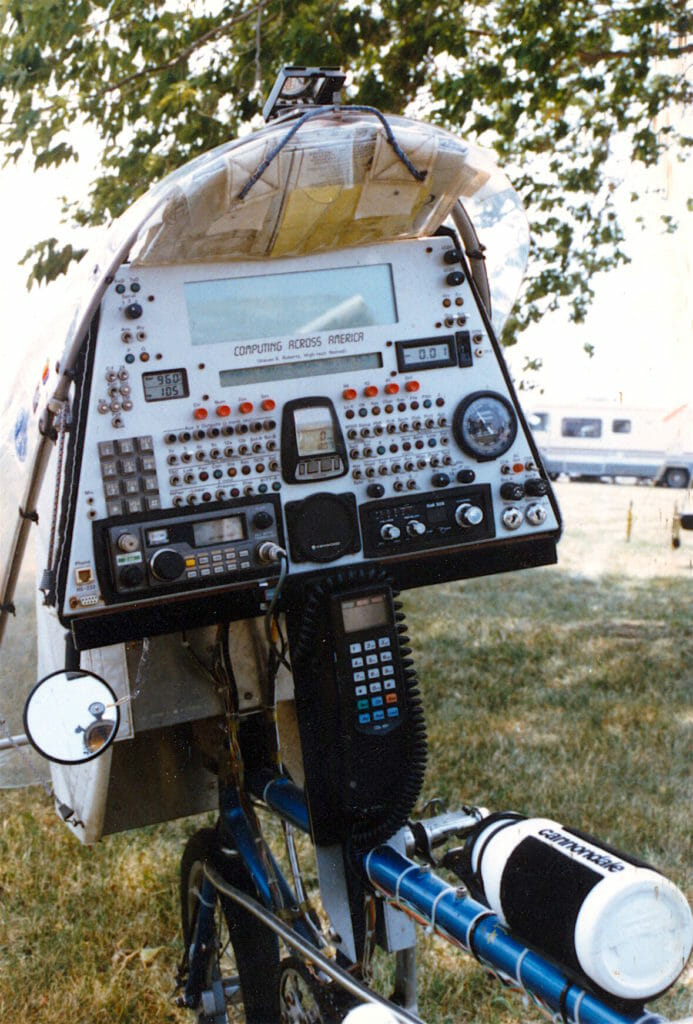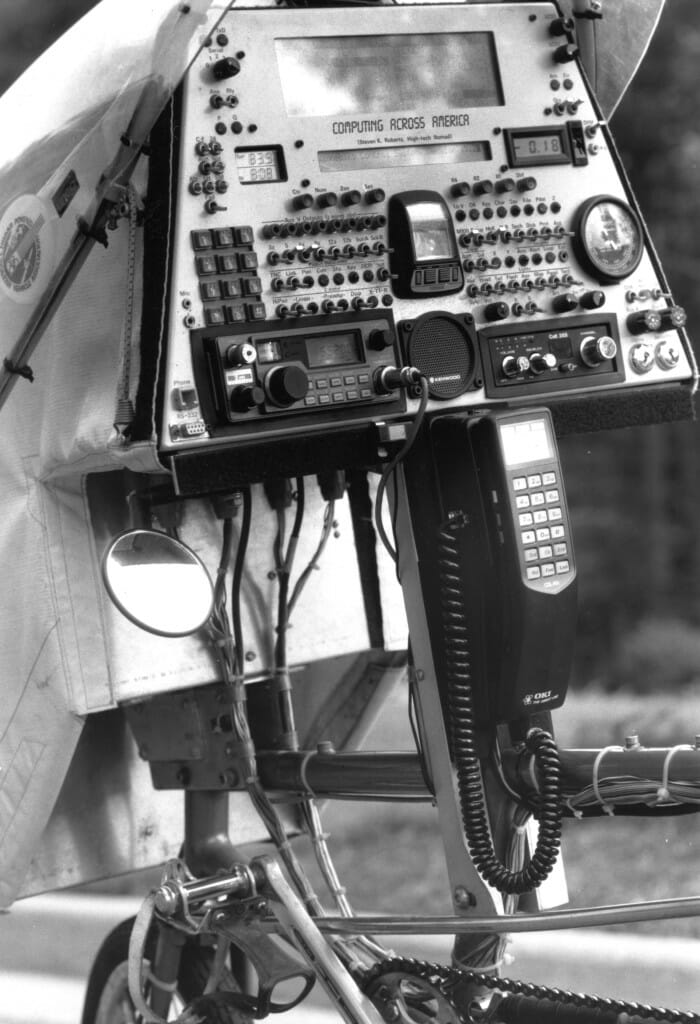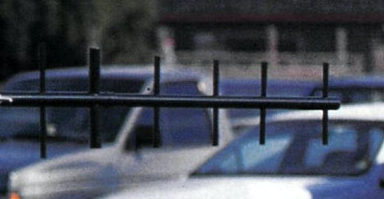
On the Road with Laptops and Cellulars – InfoWorld
Steven Roberts, author of Computing Across America, has traveled across the United States on his “Winnebiko II,” a 54-speed recumbent bicycle equipped with a cellular phone, a modem, a ham radio station, a fax machine, a TV set, CD ROM navigation libraries, a satellite earth station, a 286-based computer with more than 4 megabytes of RAM, almost 50 megabytes of disk storage, a one-of-a-kind handlebar-mounted keyboard, and a local area network (to connect the electronics together). He is currently on a Silicon Valley layover, building the Winnebiko III.
by Steven K. Roberts
InfoWorld
May 8, 1989
When you pedal into town on a loony excursion module, people naturally ask if you’re with NASA. But on-line, brain-to-brain contact is the rule — a vaporous kind of interaction that renders personal appearance and location irrelevant. I thus manage anonymity unless specific questions of lifestyle arise. “Where are you, “Wordy?” came the innocent question one sunny afternoon as I poked my head into an on-line conference area.
“Well, at the moment I’m pedaling past Calaveras Reservoir, in the mountains east of San Jose, California.”
The response: “I think I got some line noise here… looked like you said pedaling.”
Line noise? If so, it had to be on his end — for I was using an error-correcting cellular phone modem, typing on a handlebar keyboard, and watching text flow across an LCD on the bicycle’s sunlit control console.
Since 1983, I have been living on a computerized recumbent bicycle — making a living as a writer and consultant while traveling full time around America. It’s a good life, fraught with sweat and danger as well as crazy extremes of technoid gizmology, and the constant upgrades to the Winnebiko have become as much of an adventure as the travel.
The essence of the whole affair centers around information processing and communication but includes a wild variety of support systems. There are solar panels and batteries, along with a dedicated power management processor to keep them all happy. There is a satellite earth station for global ham radio coverage as well as a more traditional HF and VHF ham shack. The bike carries an automatic transmission, a regenerative braking system, a solar-powered refrigerator for drinking water, a trailer full of camping and R&D facilities, a microfiche documentation library, a CD ROM map database of the whole United States, VGA graphics for CAD and other display-intensive operations, a fax board, and a local area network of robust processors and file servers extended via 1,200-bps UHF radio link to a laptop in my backpack. And, of course, there is an Oki 491 cellular phone.
In a life of full-time travel, cellular service is at once useful and frustrating. Useful because I’m no longer entirely dependent on clunky, uncomfortable pay phones. Frustrating because the network is still immature: It’s a mad tangle of competing services with inconsistent billing standards and no guarantee of “roamer” coverage from one region to the next. This can be taken care of to some extent by hacking the phone with electronic switching of Number Assignment Modules depending on where I happen to be. And I have partially solved the problem of rural coverage gaps with the addition of a six-element Larsen yagi antenna that extends my range to more than 100 miles.
All of which is fine, but when a confirmed denizen of Dataspace like me adds a cellular phone to a computerized bicycle, the next move is obvious. What good is a telephone without a modem?
GOING ON-LINE FROM THE ROAD
Hooking a laptop to a cellular phone is not a simple matter of plugging in a modular jack and tapping out the familiar ATDT command. For one thing, few phones present a clean RJ11 interface to the outside world. A larger problem still is the modem’s reaction to noise and handoffs.
If you’ve ever used a cellular phone, you’ve heard them both — and you have taken advantage of your brain’s error-correction capability to counteract the effects of noise, multipath distortion, fading, and the half-second gaps that occur when calls are handed off from one MTSO (Mobile Telephone Switching Office) to another. You either extrapolated across missed words, using intelligence to fill in the gaps, or you said. “What? This dang thing went dead for a second.”
Normal modems can’t do this. Noise produces garbled data; handoffs cause loss of carrier and instant disconnection. While you could somewhat offset these problems by using an Xmodem-like protocol and holding real still on a hilltop while transmitting, this is a poor solution: Most on-line time is not spent in coordinated file transfers, and “directed handoffs” can occur for load-leveling reasons even if the car from which you’re calling is up on blocks.
The magic black box that makes the whole cellular phone system transparent to data transmission is the Spectrum Cellular Bridge modem, along with a corresponding Spectrum Cellular Span attached to the host end of the link. These devices ($595 each) employ an adverse environment protocol termed SPCL, which uses forward error-correction techniques to fix noise- and fade-related errors as well as error detection and correction for the extensive dropouts caused by handoffs and fringe-area use. The net effect is a mere slowing of perfect data as the channel quality degrades, but there is never any hint of line noise. It’s cleaner and more transparent than most direct-connect environments I’ve encountered and obviously superior to all acoustic coupler connections.
The Bridge modem contains a CMOS Z80, well-suited to battery operation. Interfacing details depend on the particular type of cellular phone involved, but basically amount to inserting the Bridge between the handset and the transceiver. It draws its operating power from the phone and presents a DB-25 connector to your laptop or other datacomm device.
If you want full error correction, there must be a Span modem somewhere in the system — at the host computer, the local MTSO, or in your office connected back-to-back with another modem through which you dial out. Spectrum Cellular reports that Spans are now built into dozens of cities’ service areas (there’s a two-page list), and Telenet and CompuServe both offer their customers this error-free communication option. If there’s no Span in the loop, the Bridge acts as a normal 300/1,200-bps modem.
OTHER RADIO DATACOMM OPTIONS
I should mention another trend in the mobile data world, one that is fast exploding into an industry unto itself. Why run wires when you want to network computers together? On the bicycle, I use an RF data link to allow a lightweight backpack laptop to easily access the on-board file server: a robust 286 machine with a 40-megabyte hard disk, extended memory, math coprocessor, CD ROM drive, and streamer tape backup unit. This is not something I’d want to lug around over my shoulder, but I am willing to pedal it.
The problem is that most of my life is not spent pedaling. I visit people, climb mountains, sit in tents and hostels, hunker over borrowed desks, and generally find a small laptop with no moving parts to be much less trouble than the 15-pound power-hungry behemoths that populate the industry. Trouble is, the behemoths have the computing power I need.
The solution is simple. As long as I’m within a few miles of the bike, I can sign on via a Maxon data radio. First I encounter the BBS-like front end of the attached PacComm terminal node controller. A quick command powers up the FORTH bicycle control system, allowing full access to security, power management, and network commands. A special word then boots the 286 and invokes a shell program that effectively puts me at the console of the big machine on the bike — even if I happen to be perched on a mountaintop. At this point, I can dial out through the cellular phone to upload E-Mail to my home network (GEnie), grab a text file from hard disk, dig through my databases, or access CD ROM map files to find out where the heck I am.
Data communication via radio is fast becoming big business, with systems going on-line in airports, major courier services, warehousing installations, and in just about any environment where geography, regulations, or the need for mobility precludes traditional wire or fiber links. Data rates from 1,200 to multimegabaud are available in a variety of network configurations. (Most popular protocols are derivatives of X.25 packet networks and time-slice polling schemes).
I predict that laptops of tomorrow will have, as a standard option, a rubber-duckie antenna poking out from the rear panel. They will be nodes in a wide-bandwidth global network that can carry digitized voice mail, fax, and standard data files, linking mobile users wherever they may be. Microwave and satellite backbones will spring up to provide data highways between major local networks, but otherwise the whole affair will be a sort of digital ad-hocracy that depends upon its own users for message forwarding, unrestricted by artificial boundaries such as national borders. The sole remaining barrier to such free networking is regulatory, and that will fall (hopefully) as soon as economic pressure makes a chunk of public digital spectrum space an attractive financial resource.
TECHNOLOGY MARCHES ON
Radio data links are changing the shape of networks, breaking one more chain in the mad information tangle that keeps people tied to desks against their will. Years ago, journalists rhapsodized about the coming computer age with glorious words of liberation. “Computers will free mankind from intellectual drudgery,” they said, “allowing us at last to turn our minds to loftier pursuits.” We all know what happened instead: The tyranny of information became worse than ever, as we labored harder and harder to keep up with the complexities of these machines and the glut of information that was supposed to make our lives easier.
A true solution to that problem is still years away, but liberation has materialized from an unexpected quarter: physical disconnection from the desk. Suddenly, all it takes to be permanently free of wires is a solar panel, a battery, a suitable laptop, an on-line account or two, and a radio data link of appropriate scale (depending on the data rate you need and how far you want to be from the physical manifestations of civilization).
So despite the continuing confusion of OSes, incompatible TSRs, not-quite standards, competing user interfaces, and the nifty applications that make us put up with all the rest, this technology is actually liberating in the extreme, for as long as we deal primarily with information. we can now put our bodies where we like.
Cellular Modems — A Few Application Ideas
Now that the tools for mobile data communication are at hand, a number of interesting applications are emerging. All of the following are already in place:
City buses in Dallas, Cincinnati, and Seattle are test sites for a new twist in advertising. Three-foot-by-9-inch digital signs contain Bridge modems and cellular phones and display not only up-to-the minute news but also advertising messages tailored to the specific route of the bus. An added feature is quick communication with bus drivers in the event of trouble.
Water treatment plants offer cellular access to control and monitoring units. Remote diagnostics for vehicle-mounted systems, isolated cable TV sites, network nodes, and the like can all be handled via a low-cost link without having to install dedicated lines.
Real-estate agents use laptops and cellular modems to access multiple listings services while driving around with clients. The St. Petersburg, Florida, police use cellular modems to handle accident reports without burdening already overloaded voice channels.
Insurance marketers drive a “benefits van” with a data link back to home office computers. (Sales force automation is changing rapidly, with national access to databases now only a mobile phone call away.)
Attorneys carry laptops into court rooms. They use cellular modems to access Lexis and other legal information services as needed.
Delivery vehicles receive routing and other updates on the fly. This application is taking hold across the whole spectrum of delivery services, from high-performance global couriers to local pizza vans.
Manufacturers, warehouses, and even airports are starting to use RF-linked bar-code scanners to aid in material handling and item tracking.
Nomadic journalists (like me) use the technology to file stories from the field (including digitized images like those the Canon still video system can produce). Sports reporters can escape the press box and file from the sidelines, while the rest of us can work closer to deadline than ever.
— Steven K. Roberts
The next article in this InfoWorld series… Packet Radio: Networks Without Wires






You must be logged in to post a comment.